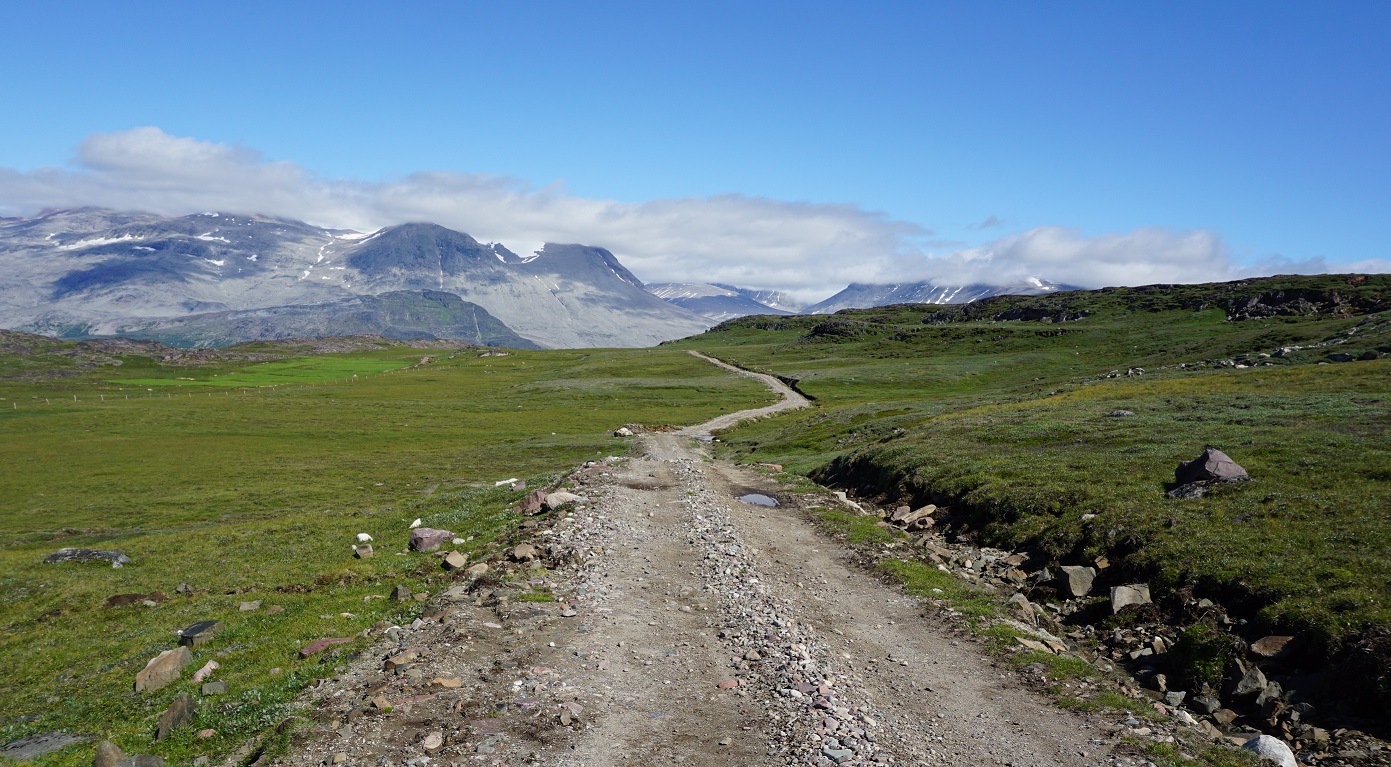Rules
The following rules are to ensure that as many guests as possible can enjoy the world heritage site, without wearing it down.
Graves and turf ruins: Both are protected by the heritage act, which means you cannot destroy them. Every year open graves are found, which is both disrespectful and speeds up the decomposition process. It is not allowed to walk on, open or dig inside any prehistoric relics.
Camping: You can put up your tent and make a fire, but not too long time and the same place. In periods with little precipitation, be careful or avoid making a fire.
Mountain biking: A good idea – on the roads.

Road between Itilleq and Igaliku, component area 2, photo Arnaq Bjerge KUJATAA
Hunting and fishing: is allowed as long as you follow the law. Tourists must have fishing permit.
Plants: One should not pick the flowers or in other ways destroy the vegetation in the world heritage areas.
Litter: It is not allowed to leave any garbage in the nature. Set an example and bring any garbage you may find. You can tell others about it – if you have collected garbage.
Sailing: When sailing there should be a guide onboard, with knowledge about protection of the nature.
On land: We recommend that you follow marked and resommended paths and roads; both for your own safety, and for protection of the nature.
Legislation
KUJATAA was included to the world heritage list in July 2017.
In 2010 the government of Greenland enacted the protection and heritage act in May 2010
And in 2016 the announcement on cultural protection of a historic area in South Greenland was enacted.
The law and the announcement are based on the special values of the area and the protection of these. This has been acknowledged by Kommune Kujalleq, the Greenland Government and UNESCO World Heritage.
The purpose of KUJATAA is to ensure the unique agricultural culture that excisted in two periods; Norse time and modern time. To give an understanding of the area, the world heritage office, in coordination with other, make signs, better landing facilities, path systems, ruin protection, behavorial regulation and much more.
Still room for most activities
The regulations has been made with respect for the agriculture in the areas. There is access to the area as long as you follow the regulations. It is still allowed to hike, hunt, fish, collect berries and camp in the component areas.
KUJATAA world heritage office
Kommune Kujalleq prioritates the work with the world heritage very high.
At the world heritage office we manage the components in cooperation with the municipality and the Greenland Government. Managing the heritage area means protecting the values with foundation in the status as World Heritage site. There is a site manager and a park ranger at the office.
What does the heritage office work with?
Management and administration (preparation of the administration plan, the monitoring plan, and official hearings).
Mediation of issues associated with the area (website, signposting, folders, informative films, etc.).
Facilities in the area (pathway systems, landing facilities etc.)
Information for – and dialogue with – the users of the Icefjord area, including citizens, companies, associations, scientists, etc.
Being available to the press and assisting during official visits to the area.
The heritage office is financed by Kommune Kujalleq. Most of the facilitation tasks are widely financed externally. The office is without connection to private companies and commercial interests.
Monitoring
Being a World Heritage Site, means that we monitor the area and ensure that the area does not lose its values.
Monitoring the world heritage KUJATAA is performed on these criterias;
Focused on the values based on the world heritage status
Focused on the areas with most human impact
Focused on realistic measurements of the area.
Contact
KUJATAA World Heritage
Kommune Kujalleq
Boks 514
3920 Qaqortoq
Mails:
hard@kujalleq.gl
ranger@kujalleq.gl
Park Ranger:
Arnaq Bjerge Petersen
Site Manager:
Alibak Hard
World heritage – status and responisbility
KUJATAA was enlisted on the world heritage list in July 2017.
Since the world heritage list was established in 1972, more than a thousand places have been enlisted. Most of them are cultural sites (they are relatively easy to describe), a 180 as natural heritage (many things are described for the first time) and 27 are both culture and nature sites. Among the most famous World Heritage sites are the egyptian pyramids, the great wall of China and Grand Canyon.
World heritage is to be protected and nurtured.
When a place becomes a World Heritage Site, recognition and status comes with it. At the same time it is required that it should not devalue over time. There are more and more demands for management of UNESCO’s world heritage sites the past years. There has to be made management plans, monitoring plans, risk evaluations and UNESCO is to be informed about changes and plans for changes in the components.
If UNESCO thinks that a world heritage site is not properly managed and protected, they can take away the status.
What is UNESCO’s World Heritage List?
UNESCO is the United Nations organisation for education, science and culture. The organization established the world heritage list in 1972.
The purpose is to protect the worlds nature and culture against destruction, so that the worlds population can access areas with natural and cultural values. More than 186 countries have cosigned the treaty.
UNESCO is continously creating better conditions for dialogue between civilization, cultures and peoples around the world. All members of the United Nations are automatically also members of UNESCO.
Apart from protecting the areas on the list, UNESCO is using a lot of ressources on improving schools and educational material.
The head office of UNESCO World Heritage is situated in Paris.